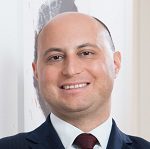In the new case Royalty Pharma C-650/17 the CJEU provided further clarifications on the interpretation of Article 3(a) of Regulation No. 469/2009/EC for products covered by a functional definition but developed after the filing date of the patent as a result of an independent inventive step
On April 30, 2020, the CJEU delivered its judgment in Case C-650/17 Royalty Pharma following the reference for preliminary ruling by the German Federal Patent Court, which was seeking guidance on the interpretation of Article 3(a) of Regulation No. 469/2009/EC (“Regulation”). The main case originated from Royalty Pharma’s application for an SPC for the diabetes product Januvia, rejected by the German Patent Office (DPMA) due to failure to comply with Article 3(a) of the Regulation. The product comprised the active ingredient sitagliptin, a DP IV inhibitor, and the basic patent EP1084705 effectively claimed DP IV inhibitors defined as a functional class for the treatment of diabetes. However, sitagliptin was not disclosed in individual form in EP1084705 and it was developed after the filing date of the basic patent by a licensee that obtained a separate patent for sitagliptin, on the basis of which it was granted its own SPC.
In its request for a preliminary ruling, the German Federal Patent Court was seeking guidance in order to understand to what extent an active ingredient that is neither expressly mentioned in the claims nor specifically mentioned in the patent, but which is covered by the functional definition in the claims of that patent, is protected even if that product was developed only after the filing date of the patent as a result of an independent inventive step. In this respect the Patent Court underlined differences among the EU Member States in their interpretations of the criteria developed in the case-law of the Court of Justice on Article 3(a) of the Regulation, making reference, among others, to the interpretation provided by the UK High Court of Justice of England and Wales, Chancery Division (Patent Court), according to which the concept of “the core of the inventive advance” would be applicable to Article 3(a) of the Regulation.
Initially, the decision was joined with case C-114/18, Sandoz/Searle. However, the Court of Appeal of England & Wales in referring said case withdrew its referral following the decision in Teva/Gilead in C-121/17, dated 25 July 2018, which was the first SPC judgment rendered by the Grand Chamber of the CJEU and was supposed to set a final standard for the assessment of the contentious Article 3(a) of the Regulation. However, the German Federal Patent Court still requested a decision in view of remaining uncertainties on the interpretation of said article with reference the following three questions submitted the CJEU:
“Is a product protected by a basic patent in force pursuant to Article 3(a) of Regulation [No. 469/2009] only if it forms part of the subject matter of protection defined by the claims and is thus provided to the expert as a specific embodiment?
“Is it not therefore sufficient for the requirements of Article 3(a) of Regulation [No. 469/2009] if the product in question satisfies the general functional definition of a class of active ingredients in the claims, but is not otherwise indicated in individualised form as a specific embodiment of the method protected by the basic patent?
“Is a product not protected by a basic patent in force under Article 3(a) of Regulation [No 469/2009] if it is covered by the functional definition in the claims, but was developed only after the filing date of the basic patent as a result of an independent inventive step?”
In its judgment, the CJEU seems to follow its previous case law, particularly its recent case Teva/Gilead. Indeed, in Royalty Pharma the CJEU expressly clarified that its interpretation of Article 3(a) in the Teva/Gilead case did not accord any relevance to the “core inventive advance” of the basic patent. Rather, it stressed the important role of the claims pursuant to Article 69 EPC and the respective Protocol, confirming that the subject matter of the protection conferred by an SPC should be limited to the technical specifications of the invention protected under the basic patent as claimed. Going further, in Royalty Pharma the CJEU also maintains that granting an SPC for a product that falls within a general functional definition used in the claims of the patent, but which is not derivable from the patent as a specific embodiment in individualized form, is not in principle precluded. In such a case, the product is nevertheless protected by the basic patent within the meaning of Article 3(a) if two conditions are satisfied: (i) the product must, from the point of view of a person skilled in the art and in the light of the description and drawings of the basic patent, necessarily come under the invention covered by that patent; and (ii) a person skilled in the art must be able to identify that product specifically in light of all the information disclosed by that patent, on the basis of the prior art at the filing date or priority date of the patent concerned.
In light of the above, the degree of specific identification therefore seems to play a fundamental role, since the subject-matter of the SPC concerned should be within the limits of what a person skilled in the art may deduce directly and unequivocally from the specifications of that patent, as filed, at the date of filing or at the date of priority of the basic patent, on the basis of their general knowledge in the relevant field at the date of filing or at the date of priority and with regard to the state of the art at the date of filing or at the date of priority. An SPC also potentially could be granted if the product could not be individually inferred as a concrete embodiment from the basic patent. However, if the product only falls under a “functional definition” of the claims, the skilled person must be able to deduce directly and unequivocally from the patent specification — as filed — that the product that is the subject-matter of the SPC falls within the scope of the protection conferred by that patent. On the other hand, the CJEU held that a product that was developed only after the filing date or priority date of the basic patent, as a result of independent inventive activity, could not fall within the scope of the protection conferred by that patent. In this regard, it would be irrelevant if such a product fell under a functional definition of the claims in the basic patent because granting an SPC for a product not covered by the basic patent would be contrary to the objectives of the Regulation, as it would not reward research results claimed by that patent itself.
Finally, the CJEU also confirms, in its preliminary observations, that the test established by the Court in Teva/Gilead is applicable not only to combinations of active ingredients, but also to single active ingredients, thereby clarifying a conflicting interpretation arising on this point.
Based on the above, the CJEU ruled that “Article 3(a) of Regulation (EC) No 469/2009 of the European Parliament and of the Council of 6 May 2009 concerning the supplementary protection certificate for medicinal products must be interpreted as meaning that a product is protected by a basic patent in force, within the meaning of that provision, if it corresponds to a general functional definition used by one of the claims of the basic patent and necessarily comes within the scope of the invention covered by that patent, but is not otherwise indicated in individualised form as a specific embodiment of the method of that patent, provided that it is specifically identifiable, in the light of all the information disclosed by that patent, by a person skilled in the art, based on that person’s general knowledge in the relevant field at the filing date or priority date of the basic patent and on the prior art at that date.
“Article 3(a) of Regulation No 469/2009 must be interpreted as meaning that a product is not protected by a basic patent in force, within the meaning of that provision, if, although it is covered by the functional definition given in the claims of that patent, it was developed after the filing date of the application for the basic patent, following an independent inventive step.”


